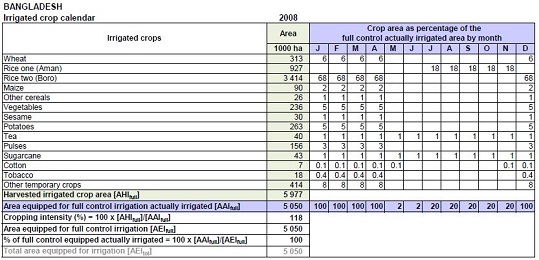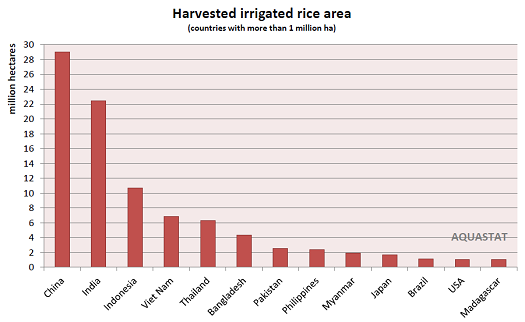AQUASTAT - FAO's Information System on Water and Agriculture
Irrigated crop calendars
Climate is a limiting factor for crop growth. If temperature is suitable for crop growth all year round, then the availability of sufficient rainfall determines the growing season for rainfed crops. Irrigation takes away the water availability constraint and could then allow cultivating all year round. For the purpose of increasing the data and information on irrigation water requirement, irrigation water withdrawal and irrigation efficiency, AQUASTAT has undertaken a major review of typical irrigated crop calendars by country. These irrigated crop calendars provide for each country data and information on: the area equipped for irrigation, the area actually irrigated, the harvested irrigated crop area, the irrigated area by crop and the percentage of irrigated area by crop occupied by month. The calendars refer to the years for which data was available.
Irrigated crop calendars for the countries are organized in Excel format in different sheets, along with their respective narratives.
Methodology used to prepare the irrigated crop calendars by country
AQUASTAT data of harvested irrigated area by crop at the national level—for harvested crops irrigated by full control irrigation only (AHIfull)—are converted into an irrigated crop calendar, which details monthly occupation rates of the area equipped for full control irrigation actually irrigated (AAIfull) for each crop. The ratio between the harvested irrigated crop area and the actually irrigated area is called "cropping intensity":
Cropping Intensity = 100 x AHIfull / AAIfull
When no data relating to irrigated harvested crop areas is available in AQUASTAT for a country, the irrigated crops database produced in the framework of the FAO perspective studies World agriculture: towards 2030/2050 (FAO, 2006) and/or "World agriculture: towards 2050/2080" (FAO, 2011a) is used.
Crop calendars are prepared for a specific year for which data are available. As much as possible AHIfull and AAIfull are selected for the same year indicated at the top of the crop calendar (for example 2008 for Bangladesh’s calendar in Table 1 below). Otherwise a note following the AAIfull figure indicates its corresponding year. This is also the case for the area equipped for full control irrigation (AEIfull) and the total area equipped for irrigation (AEItot), which are also shown in the table below as well as the percentage of the full control equipped area that is actually irrigated in the given year.
Click the table to magnify
TABLE 1
.
Example of an irrigated crop calendar: Bangladesh

Different cropping cycles of a same crop appear on different lines of the calendar. For example, in Bangladesh rice is cultivated from July to November (Rice one) and from December to April (Rice two). Crops are classified and ordered according to the World programme for the census of agriculture 2010 (FAO, 2005b). In particular, this means that distinction is made between temporary and permanent fodder crops, as well as between temporary and permanent meadows and pastures. While temporary fodder crops and temporary meadows and pastures are included in the FAOSTAT definition of arable land, in its definition of permanent crops only permanent fodder crops are included but not permanent meadows and pasture. Thus in the AQUASTAT definition of cultivated land—being the sum of FAOSTAT’s arable land and permanent crops—permanent meadows and pastures are not included. In a very few cases this might lead to the irrigated area being larger than the cultivated area.
For three large countries where irrigation is relatively intensive (China, India, United States of America), irrigated crop calendars have been prepared by sub-national zones (north, south, west, east) to more closely reflect the climate variations. On the contrary, the nine small islands from the Caribbean Lesser Antilles (CARL) have been combined into a single crop calendar due to limited irrigated areas and limited available data for each of them separately. These geographical divisions or groupings are detailed in the respective crop calendars.
Regional summary of the irrigated crop calendars
Data obtained in the irrigated crop calendars of individual countries is compiled and analyzed by continent, by (sub-)region and by income-based grouping: high, middle and low income. Special attention is given to the 61 low income food deficit countries (LIFDC)—of which 37 are in Africa—and the 40 least developed countries (LDC)—of which 30 are in Africa—since water, and in particular agricultural water, is a significant developing incentive for food security and rural development. Annex 2 lists alphabetically the countries included in this review for the world, by continent, by region and sub-region, by income-based grouping as well as the LIFDCs and LDCs, as per October 2012. It also provides the definitions of high, middle and low income, as well as LIFDC and LDC.
First, the regional analysis examines regional specificities with regards to AHIfull, cropping intensity, AAIfull, AEIfull and AEItot (Table 2a). (Table 2b) gives the percentage of the world total for AHIfull, AAIfull, AEIfull and AEItot in each country grouping. Then, regional features of irrigated harvested crops—in hectares (Table 3a) or in percentage (Table 3b, Table 3c) — and irrigated harvested cereals in particular (Table 3d and Table 3e), are detailed.
Areas equipped for irrigation, areas actually irrigated and cropping intensity
AQUASTAT makes to following distinction (Figure 2) with regards to agricultural water management, where "Area equipped for irrigation" is equal to AEItot in this review and "Area equipped for full control irrigation" equal to AEIfull (green boxes).
FIGURE 2 . AQUASTAT classification of areas under agricultural water management

Note: _the boxes in white refer to variables that are not available in the AQUASTAT database _
Africa is the only continent where the area equipped for full control irrigation (AEIfull) is significantly lower than the total equipped area for irrigation (AEItot). AEIfull accounts for 93 percent of AEItot, whereas it is 99 percent in Asia and Europe and more or less 100 percent in the Americas and Oceania (Table 2a). This is due to significant areas of equipped lowlands in Sub-Saharan Africa and spate irrigation mainly in Northern Africa and the Sudano-Sahelian sub-region. However, because they rely on floodwater, they cannot completely uncouple irrigated crops from climatic conditions like full control irrigation does. Asia with 71 percent of the AEItot and AEIfull worldwide represents 78 percent (Table 2b) of the global AHIfull thanks to its high cropping intensity, but also to the largest part of AEIfull that is actually irrigated (AAIfull). In Europe the percentage of AEIfull actually irrigated is more limited (65 percent). European irrigation is indeed strongly dependent on precipitation and, in a lesser extent, on mobile irrigation equipment, the intensive use of which—by applying water to different plots with the same mobile equipment—in fact expands areas considered equipped for full control irrigation. In addition, the climatic conditions allowing various cropping cycles in a year in large parts of Asia, Africa and Americas, make a significantly larger cropping intensity possible in these regions than in parts of Europe and Oceania, where irrigated crop growth in the winter season is little or non-existent.
The combination of high cropping intensity and high rates of AAIfull/AEIfull makes that Asia and Africa benefit the most of irrigation. In fact, it is worth mentioning that LIFDCs take full advantage of irrigation with their cropping intensity close to the world average and with a very high level of areas equipped for irrigation that are actually irrigated. Similarly, the LDCs have a cropping intensity larger than high income countries, despite their lower portion of areas equipped for full control irrigation relative to their total area equipped for irrigation (AEIfull/AEItot), which is explained by the fact that the majority of LDCs are located in Sub-Saharan Africa, where most of the equipped lowlands can be found.
Irrigated harvested crops
On average, cereals are the main irrigated crops (61 percent) (Table 3a and Table 3b) and 87 percent of the irrigated cereals is grown in Asia (Table 3c). Almost half of the world’s irrigated cereals is rice (Table 3d and Table 3e), which is thus the main irrigated crop worldwide (29 percent of irrigated crops). And more than half of the global harvested irrigated rice area is located in just two countries: China and India.
Click the chart to magnify
However, while rice is the main irrigated cereal in Asia, rice and wheat are the main irrigated cereals in Africa, maize dominates in Americas and Europe, and wheat in Oceania. These ascendancies nearly reflect the continental respective traditional food preferences, except for wheat, the preferred cereal in Europe and in a lesser degree in Americas, which is mostly grown in winter under rainfed conditions. At continental level, Oceania—limited to Australia and New Zealand in this study—is the only single exception to the irrigated cereals’ large domination, with irrigated fodder and pastures representing almost half of the irrigated crops (48 percent). At a smaller scale, irrigated fodder and pastures in the Eastern Europe and Russian Federation region also largely prevails (51 percent) over irrigated cereals (17 percent).
The diversification of irrigated crops increases in countries with a higher income (Table 3b): the part of cereals in irrigated crops varies a lot between high income countries (38 percent), middle income countries (64 percent), and to low income countries (75 percent). With 76 percent of the irrigated areas of the LDCs dedicated to cereals, irrigation there focuses on provision of staple food. In high income countries vegetables, fruits, oilseed crops, and fodder and pasture diversify the irrigated crops with their respective proportion being significantly larger than in other income-based groups and even the world’s averages. This diversification by irrigation, and the relatively diversified average diet it mirrors, is however coupled with a lower physical productivity of irrigation water, in term of final product destined for human consumption, due to large volume of irrigation water dedicated to fodder and pasture and required to produce meat. On the other hand, diversification of local diets from irrigation in low income countries and LDCs is not only limited by the large portion of cereals but also by the allocation of irrigated areas to export crops, such as beverage crops (cocoa, coffee, tea). This is also the case in LIFDCs where irrigated export crops, such as sugar crops (sugarcane and sugar beet) and fibre crops (including cotton), almost match the world’s averages despite their larger portion of irrigated cereals and their need of locally consumed crops—their irrigated vegetables, fruits and oil crops fail to reach the world’s averages. These latter three crop groups represent 30 percent of the irrigated crop areas in high income countries, against 9 percent in LIFDCs. In spite of their relatively high cropping intensity and level of areas equipped actually irrigated as shown in (Table 2a), irrigation could play a greater role in the fight to achieve food security of these LIFDCs, and in particular through diversification of crops with larger areas dedicated to these three crop groups (vegetables, fruits and oil crops).
Based on the above irrigated crop calendars, the irrigation water requirement corresponding to these irrigated crops (2nd step) is calculated.
